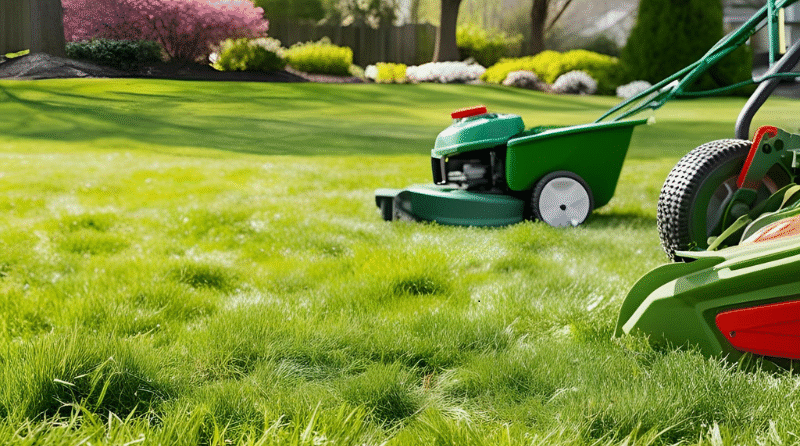Why Spring Is the Best Time for a Lawn Makeover
As the frost fades and the days grow longer, your lawn wakes up from its winter slumber. Spring is the perfect time to assess damage, repair bare patches, and lay the foundation for a lush, green yard all summer long. A proper spring lawn care routine boosts grass growth, improves soil health, and keeps weeds in check.
Step 1: Dethatching – Clearing the Way for Growth
What is thatch?
Thatch is the layer of dead grass, roots, and debris that builds up between the soil and the living grass. A thick layer can prevent water and nutrients from reaching the roots.
How to dethatch your lawn:
- Use a thatch rake for small yards or rent a power dethatcher for larger areas.
- Remove all debris and bag up the thatch.
- Water the lawn lightly after dethatching to help recovery.
Consider scheduling a dethatching service early in the season for better soil performance and healthier turf growth.
Step 2: Aeration – Let Your Lawn Breathe
Soil compaction happens during winter, especially in areas with foot traffic or snow accumulation. Lawn aeration allows air, water, and nutrients to reach deep into the soil.
Best practice:
- Use a core aerator to remove small plugs of soil.
- Aerate when the soil is moist—not too wet or dry.
- Combine aeration with seeding for maximum results.
Improve root development and reduce soil compaction with proper core aeration during spring.
Step 3: Overseeding – Fill in the Bald Spots
If your lawn has patches or thinned-out areas, overseeding will thicken the grass and improve its overall appearance.
When and how to overseed:
- Do this after aeration for best seed-to-soil contact.
- Use a seed blend that suits your region and sunlight level.
- Water consistently for the first 2–3 weeks to ensure germination.
Pair overseeding and fertilization for better lawn density and long-term health.
Step 4: Fertilizing – Feed for the Future
Apply a balanced spring fertilizer to give your lawn the nutrients it needs to thrive.
What to look for in a spring fertilizer:
- A nitrogen-rich blend to encourage green growth
- Slow-release formulas for long-lasting impact
- Apply when temperatures are consistently above 50°F
Spring fertilization not only boosts early growth but also complements recent seeding efforts for even coverage.
Step 5: The First Mow – Set the Right Height
Your first spring mow sets the tone for the season.
Spring mowing tips:
- Set your mower blades high (around 3–3.5 inches) to avoid stressing young grass.
- Keep your blades sharp to avoid tearing the grass.
- Mow only when the grass is dry to prevent clumping and fungus.
Need a sharp start? Lawn mowing and trimming solutions are ideal for maintaining height and uniformity throughout the season.
Bonus Step: Edge, Mulch & Refresh Your Landscape Beds
While your lawn is your main focus, don’t forget the borders. Clean up your mulch beds, prune shrubs, and edge walkways for that polished look.
To-do list:
- Freshen up mulch (2–3 inches deep)
- Trim overgrown plants and hedges
- Pressure wash hardscapes if needed
- Remove leftover debris and clippings
A full property cleanup after winter ensures your yard looks as refreshed as it feels.
Considering New Turf?
In some cases, starting fresh might be better than reviving what’s left. Spring is also the right time to evaluate if your lawn needs a partial or full replacement.
If patches just won’t fill in, consider residential sod installation to instantly renew your lawn with lush, healthy turf.
Spring Lawn Care Checklist
| Task | Recommended Timing | Tools Needed |
| Dethatching | Early to mid-spring | Thatch rake / power rake |
| Aeration | Mid-spring | Core aerator |
| Overseeding | After aeration | Seed spreader |
| Fertilizing | Mid to late spring | Lawn spreader |
| First Mow | When grass is 3–4 inches tall | Lawn mower |
Final Thoughts
A spring lawn makeover is more than just mowing—it’s a seasonal refresh that sets your yard up for success. By dethatching, aerating, overseeding, and fertilizing, you improve soil health, promote thicker grass, and reduce weeds. These essential steps help your lawn grow greener, stronger, and healthier all season long.
FAQs
Q1: What is the best time to start a spring lawn makeover?
Early to mid-spring is ideal—once the soil is no longer frozen and the grass begins to grow actively.
Q2: Should I dethatch or aerate first?
Start with dethatching to remove surface debris, then aerate to relieve soil compaction and boost root health.
Q3: Can I overseed right after aeration?
Yes! Aeration creates excellent seed-to-soil contact, which helps improve germination and fill in bare spots.
Q4: What type of fertilizer is best for spring?
Use a nitrogen-rich, slow-release fertilizer to support green growth and strengthen roots.
Q5: When should I mow my lawn for the first time in spring?
Mow when your grass is 3–4 inches tall and the soil is dry. Use sharp blades and avoid cutting too short.
Q6: Is it worth replacing parts of my lawn with sod?
If bare patches don’t recover after overseeding, consider sod installation for an instant, lush lawn.


